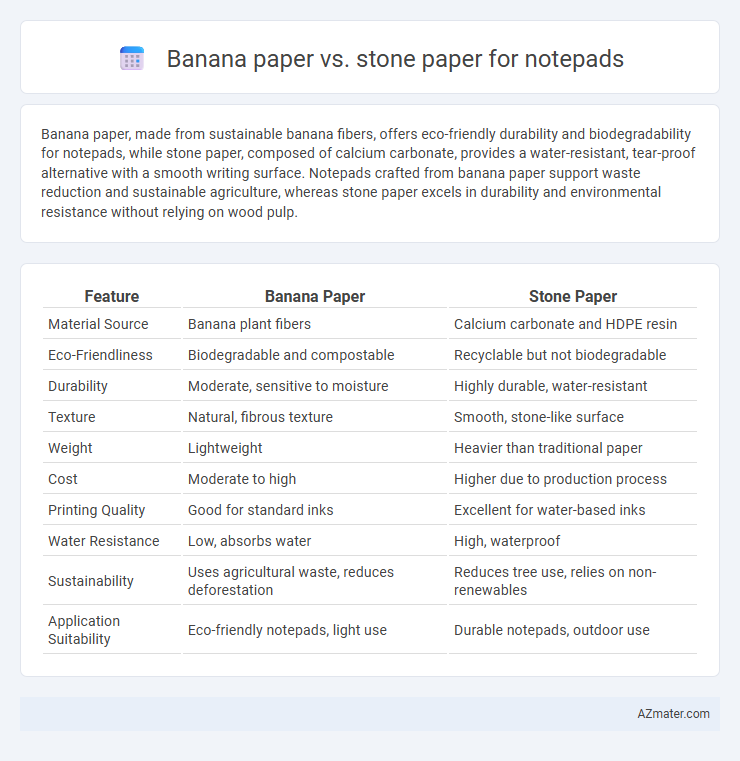Banana paper, made from sustainable banana fibers, offers eco-friendly durability and biodegradability for notepads, while stone paper, composed of calcium carbonate, provides a water-resistant, tear-proof alternative with a smooth writing surface. Notepads crafted from banana paper support waste reduction and sustainable agriculture, whereas stone paper excels in durability and environmental resistance without relying on wood pulp.
Table of Comparison
| Feature | Banana Paper | Stone Paper |
|---|---|---|
| Material Source | Banana plant fibers | Calcium carbonate and HDPE resin |
| Eco-Friendliness | Biodegradable and compostable | Recyclable but not biodegradable |
| Durability | Moderate, sensitive to moisture | Highly durable, water-resistant |
| Texture | Natural, fibrous texture | Smooth, stone-like surface |
| Weight | Lightweight | Heavier than traditional paper |
| Cost | Moderate to high | Higher due to production process |
| Printing Quality | Good for standard inks | Excellent for water-based inks |
| Water Resistance | Low, absorbs water | High, waterproof |
| Sustainability | Uses agricultural waste, reduces deforestation | Reduces tree use, relies on non-renewables |
| Application Suitability | Eco-friendly notepads, light use | Durable notepads, outdoor use |
Introduction to Alternative Papers: Banana vs Stone
Banana paper, made from the fibers of banana plants, offers an eco-friendly alternative to traditional wood pulp paper by utilizing agricultural waste and reducing deforestation. Stone paper, composed of calcium carbonate bonded with non-toxic resin, boasts waterproof, tear-resistant properties and requires no water or trees in production. Both materials serve as sustainable choices for notepads, with banana paper emphasizing natural fiber recycling and stone paper highlighting durability and resource conservation.
What Is Banana Paper? Composition and Production
Banana paper is an eco-friendly material made primarily from the fibers of banana plant stems, specifically the pseudostem, which is an agricultural byproduct after fruit harvesting. The production process involves collecting banana fiber, cleaning, boiling, and mechanically pulping it before being spread into sheets and dried, resulting in a durable, biodegradable alternative to traditional wood-pulp paper. This sustainable composition reduces deforestation and utilizes waste from banana cultivation, making it a popular choice for environmentally conscious notepads.
Understanding Stone Paper: Materials and Manufacturing
Stone paper is made primarily from calcium carbonate, a naturally abundant mineral, combined with non-toxic resin that acts as a binding agent. The manufacturing process uses a dry method that eliminates the need for water and reduces energy consumption, making it more environmentally friendly compared to traditional paper. This innovation results in a durable, water-resistant, and tear-proof notepad material ideal for sustainable stationery solutions.
Environmental Impact: Banana Paper vs Stone Paper
Banana paper is made from agricultural waste, primarily banana stalk fibers, offering a biodegradable and compostable alternative with a low carbon footprint, as it reduces deforestation and waste burning. Stone paper, derived from calcium carbonate and non-toxic resins, is waterproof and tear-resistant but is not biodegradable and depends on non-renewable mineral extraction, which generates significant environmental impact. Both materials avoid traditional wood pulp, but banana paper's renewable, waste-based sourcing provides superior environmental benefits compared to the more resource-intensive stone paper production.
Durability and Performance in Notepads
Banana paper offers moderate durability with natural fibers that provide a slightly textured surface, making it suitable for everyday writing but prone to tearing under heavy use. Stone paper, made from calcium carbonate and resin, boasts superior durability thanks to its resistance to water, tearing, and smudging, ensuring long-lasting performance in notepads. Its smooth, synthetic surface also enhances writing clarity and ink absorption, ideal for consistent, high-quality note-taking.
Writing Experience: Texture and Ink Compatibility
Banana paper offers a smooth texture with a slightly fibrous feel, providing excellent ink absorption that minimizes smudging and feathering, ideal for ballpoint and gel pens. Stone paper has a waterproof, silky surface that resists ink absorption, resulting in faster drying times but potential smearing with certain ink types, especially fountain pens. Both materials enhance writing experiences differently, with banana paper favoring traditional ink compatibility and stone paper excelling in durability and water resistance.
Cost Comparison: Affordability and Availability
Banana paper offers a cost-effective alternative to stone paper due to lower raw material expenses and simpler production methods, making it more affordable for notepads. Stone paper, though durable and water-resistant, involves higher manufacturing costs related to its mineral-based composition, resulting in a higher retail price. Availability of banana paper is expanding in regions with abundant banana cultivation, while stone paper remains less accessible and generally pricier due to specialized production requirements.
Biodegradability and Recycling Aspects
Banana paper, made from banana plant fibers, is highly biodegradable and compostable, breaking down naturally within weeks and reducing landfill waste significantly. Stone paper, composed of calcium carbonate and non-toxic resin, is water-resistant and durable but less biodegradable, often taking years to decompose in natural environments. Recycling banana paper is straightforward through organic composting, whereas stone paper requires specialized recycling processes due to its synthetic resin content.
Ideal Use Cases for Banana Paper Notepads
Banana paper notepads excel in eco-friendly and sustainable applications, ideal for businesses and individuals seeking biodegradable, tree-free alternatives with a lower carbon footprint than traditional stone paper. Their natural fiber composition makes them perfect for handwritten notes, sketching, and creative projects where a soft texture and absorbency enhance the writing experience. Suitable for eco-conscious students, artists, and companies pursuing green office supplies, banana paper offers a renewable and compostable option compared to the water-resistant and more durable stone paper.
Choosing Between Banana and Stone Paper: Which Is Best?
Banana paper offers eco-friendly benefits by utilizing agricultural waste, making it biodegradable and compostable, ideal for sustainable notepad production. Stone paper, made from calcium carbonate and resin, provides waterproof and tear-resistant qualities, enhancing durability but with limited biodegradability. Choosing between banana and stone paper depends on prioritizing environmental impact with banana paper or durability and water resistance with stone paper.

Infographic: Banana paper vs Stone paper for Notepad
 azmater.com
azmater.com